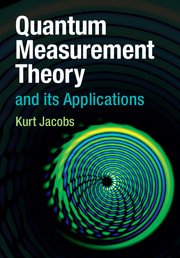Book contents
- Frontmatter
- Dedication
- Contents
- Preface
- 1 Quantum measurement theory
- 2 Useful concepts from information theory
- 3 Continuous measurement
- 4 Statistical mechanics, open systems, and measurement
- 5 Quantum feedback control
- 6 Metrology
- 7 Quantum mesoscopic systems I: circuits and measurements
- 8 Quantum mesoscopic systems II: measurement and control
- Appendix A The tensor product and partial trace
- Appendix B A fast-track introduction for experimentalists
- Appendix C A quick introduction to Ito calculus
- Appendix D Operators for qubits and modes
- Appendix E Dictionary of measurements
- Appendix F Input–output theory
- Appendix G Various formulae and techniques
- Appendix H Some proofs and derivations
- References
- Index
5 - Quantum feedback control
Published online by Cambridge University Press: 05 September 2014
- Frontmatter
- Dedication
- Contents
- Preface
- 1 Quantum measurement theory
- 2 Useful concepts from information theory
- 3 Continuous measurement
- 4 Statistical mechanics, open systems, and measurement
- 5 Quantum feedback control
- 6 Metrology
- 7 Quantum mesoscopic systems I: circuits and measurements
- 8 Quantum mesoscopic systems II: measurement and control
- Appendix A The tensor product and partial trace
- Appendix B A fast-track introduction for experimentalists
- Appendix C A quick introduction to Ito calculus
- Appendix D Operators for qubits and modes
- Appendix E Dictionary of measurements
- Appendix F Input–output theory
- Appendix G Various formulae and techniques
- Appendix H Some proofs and derivations
- References
- Index
Summary
Introduction
The notion of feedback control comes to us from the classical world of mechanical and electrical engineering. Machines designed to operate a certain way may deviate because of small errors in their physical construction, because of inherent instability, or because of external sources of noise. Such deviations can be controlled by monitoring a machine’s behavior, and using this information to apply forces that periodically or continuously correct the motion. This is called feedback control, and the device that receives the measurement signal, and translates it into the appropriate correcting forces, is called the “feedback controller” (or “controller” for short). We will usually refer to the system to be controlled as the primary, and the system that acts as a feedback controller as the auxiliary. The device(s) that actually apply the forces to the system are often called the actuator(s), and the prescription by which the control forces are chosen based on the measurement results is variously called the control algorithm, law, strategy, or protocol. Here we exclusively use the terms strategy and protocol.
Feedback control is also known as closed-loop control, because the flow of information to the controller, and the flow back to the system via actuators, are thought of as forming a loop. As a historical note, Maxwell appears to have been the first to perform a mathematical analysis of a feedback control system. He studied “governors,” mechanical devices that control the speed of an engine by using the centrifugal force generated by the engine to control the flow of fuel [413]. In fact the use of centrifugal governors goes back even further, as they were used to control the pressure between millstones in windmills in the 17th century [253].
- Type
- Chapter
- Information
- Quantum Measurement Theory and its Applications , pp. 232 - 302Publisher: Cambridge University PressPrint publication year: 2014
- 1
- Cited by



